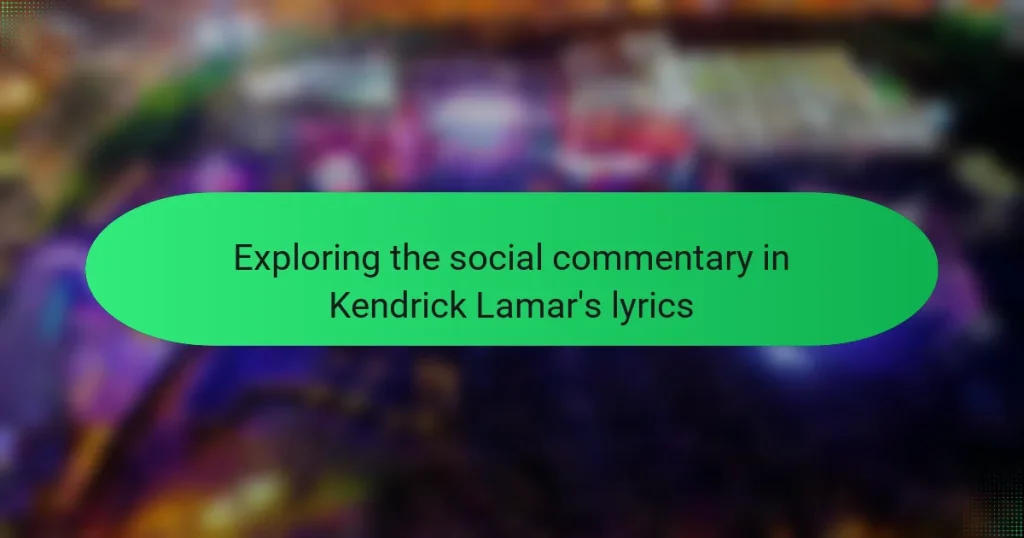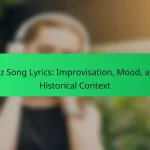Kendrick Lamar is a prominent artist known for his impactful social commentary in music. His lyrics address systemic issues such as racism, poverty, and violence, particularly affecting marginalized communities. Lamar’s songs, including “Alright” and “The Blacker the Berry,” utilize personal narratives to connect individual experiences with broader societal problems, fostering empathy and awareness. He critiques societal norms and challenges the status quo, making his work a platform for dialogue on social justice and inequality. Additionally, his intricate lyricism and diverse musical influences enhance the depth of his commentary, grounding it in authenticity and real-life events.
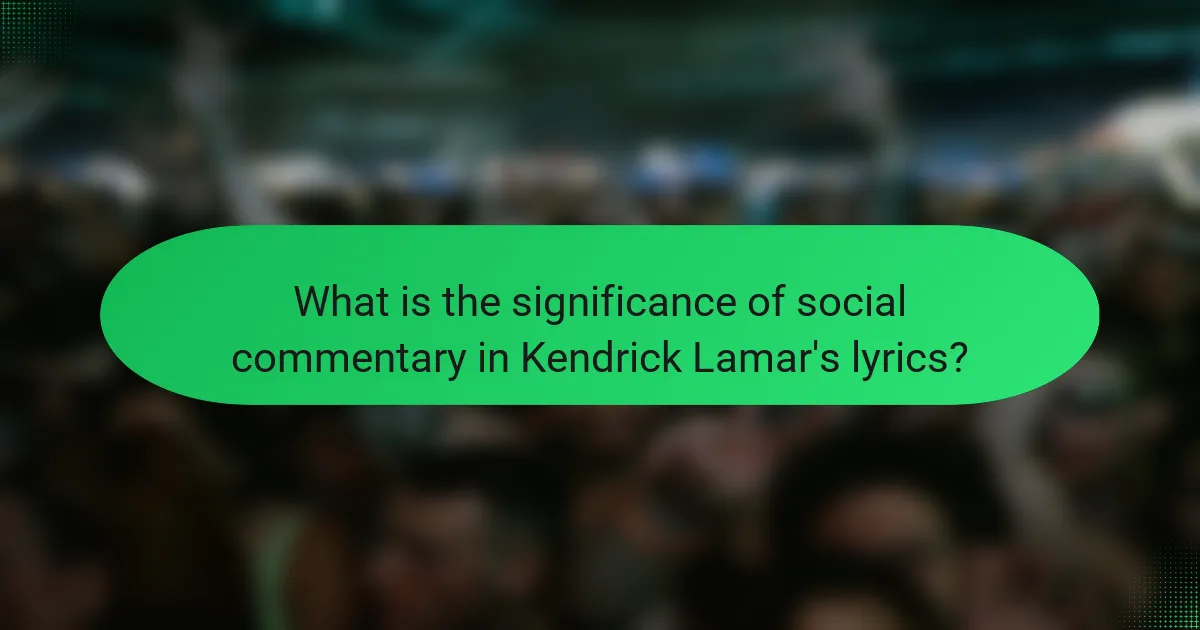
What is the significance of social commentary in Kendrick Lamar’s lyrics?
Social commentary in Kendrick Lamar’s lyrics is significant because it addresses systemic issues affecting marginalized communities. His songs often explore themes such as racism, poverty, and violence. For example, in “Alright,” Lamar conveys hope amidst despair, reflecting the Black Lives Matter movement. He uses personal narratives to connect broader societal problems to individual experiences. This approach fosters empathy and awareness among listeners. Lamar’s work often critiques societal norms and challenges the status quo. His lyrics serve as a platform for dialogue about social justice and inequality. Through his artistry, he elevates the voices of those often unheard.
How does Kendrick Lamar address social issues through his music?
Kendrick Lamar addresses social issues through his music by incorporating personal narratives and societal critiques. His lyrics often reflect experiences of racial inequality, violence, and poverty. For example, in “Alright,” he expresses hope amidst despair in the Black community. In “The Blacker the Berry,” he confronts issues of identity and systemic racism. Lamar uses storytelling to highlight the struggles faced by marginalized groups. His album “To Pimp a Butterfly” explores themes of oppression and resilience. He combines poetic devices with powerful imagery to provoke thought and discussion. This approach establishes a deep connection with listeners and raises awareness of critical social issues.
What themes are prevalent in Kendrick Lamar’s social commentary?
Kendrick Lamar’s social commentary often revolves around themes of racial inequality, systemic oppression, and personal identity. He addresses the struggles faced by the African American community. His lyrics frequently highlight police brutality and the impact of violence. Lamar also explores mental health and its stigma within his culture. He discusses the complexities of fame and its effects on personal relationships. Additionally, themes of resilience and hope emerge throughout his work. His album “To Pimp a Butterfly” serves as a critical examination of these societal issues. Through his storytelling, Lamar invites listeners to reflect on their own experiences and societal structures.
How do Kendrick Lamar’s experiences influence his lyrical content?
Kendrick Lamar’s experiences significantly shape his lyrical content. His upbringing in Compton, California, exposes him to systemic issues. Themes of violence, poverty, and racial discrimination are prevalent in his work. Lamar’s personal struggles with identity and mental health also inform his lyrics. He often reflects on the impact of his environment on his life choices. His storytelling incorporates real-life events, making his music relatable and poignant. For example, “The Art of Peer Pressure” narrates a night influenced by his peers. This authenticity resonates with listeners and enhances the social commentary in his songs.
Why is Kendrick Lamar considered a voice for his generation?
Kendrick Lamar is considered a voice for his generation due to his profound social commentary. His lyrics address systemic issues such as racism, inequality, and violence. Lamar’s storytelling resonates with the experiences of many young people today. He articulates their struggles and aspirations through relatable narratives. His album “To Pimp a Butterfly” explores themes of identity and resilience. It received critical acclaim for its honest portrayal of African American life. Lamar’s ability to blend personal stories with broader societal issues sets him apart. His work encourages dialogue about pressing social matters. This connection to his audience solidifies his role as a generational voice.
What cultural and societal factors shape his perspective?
Kendrick Lamar’s perspective is shaped by various cultural and societal factors. His experiences growing up in Compton, California, influence his worldview. The prevalence of systemic racism and socioeconomic disparities in his community is significant. Lamar often addresses issues like police brutality and inequality in his lyrics. Additionally, his African American heritage informs his understanding of cultural identity. The influence of hip-hop culture and its historical context also plays a role. His work reflects the struggles and resilience of marginalized communities. These factors collectively contribute to the depth of his social commentary.
How do his lyrics resonate with listeners from diverse backgrounds?
Kendrick Lamar’s lyrics resonate with listeners from diverse backgrounds through their universal themes of struggle, identity, and resilience. His storytelling often reflects personal and collective experiences that many can relate to. For example, Lamar addresses systemic issues such as racism and inequality, which impact various communities. The emotional depth in his narratives allows listeners to see their own lives mirrored in his words.
Additionally, Lamar’s use of cultural references makes his music accessible to a wide audience. He incorporates elements from hip-hop culture while also touching on broader societal issues. This blend creates a connection with listeners regardless of their cultural background. His song “Alright” became an anthem for social movements, showcasing its relevance across different demographics.
Moreover, Lamar’s vulnerability in discussing mental health and personal challenges resonates with individuals facing similar issues. This openness fosters a sense of community among listeners. Overall, Lamar’s ability to articulate complex emotions and social realities enables his lyrics to transcend cultural barriers.
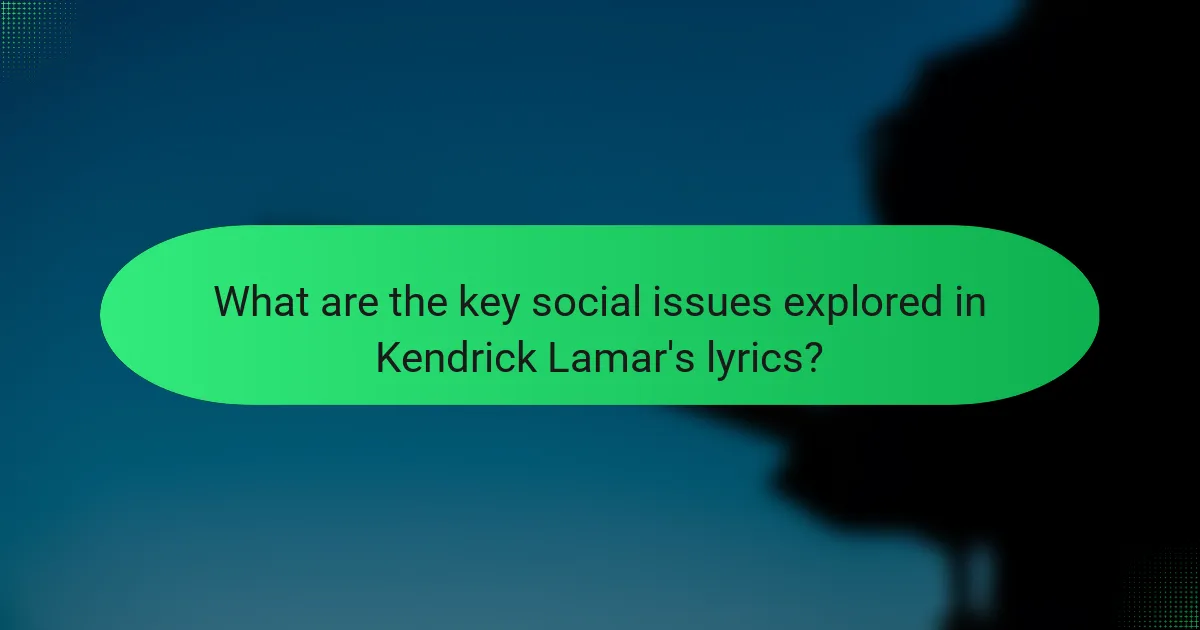
What are the key social issues explored in Kendrick Lamar’s lyrics?
Kendrick Lamar’s lyrics explore key social issues such as racial inequality, systemic oppression, and violence. He addresses the impact of poverty and police brutality on marginalized communities. Lamar’s work often reflects personal struggles and mental health challenges. He also delves into themes of identity and self-worth. His songs highlight the complexities of growing up in a challenging environment. For example, tracks like “Alright” and “The Blacker the Berry” provide powerful commentary on these issues. Through his storytelling, Lamar sheds light on the realities faced by many individuals in society. His lyrics serve as a voice for the voiceless, making significant social commentary.
How does Kendrick Lamar tackle issues of race and identity?
Kendrick Lamar addresses issues of race and identity through personal storytelling and socio-political commentary. His lyrics often reflect the struggles and experiences of Black Americans. He explores themes of systemic racism, identity, and self-acceptance. In songs like “The Blacker the Berry,” he confronts internalized racism and cultural identity. Lamar uses vivid imagery and narrative techniques to illustrate these complex topics. He also highlights the impact of historical oppression on contemporary experiences. His work encourages listeners to reflect on their own identities and societal roles. Lamar’s approach combines personal anecdotes with broader cultural critiques, making his commentary relatable and impactful.
What examples illustrate his commentary on systemic racism?
Kendrick Lamar’s commentary on systemic racism is illustrated in several of his songs. In “The Blacker the Berry,” he addresses the complexities of racial identity and systemic oppression. The lyrics confront issues of violence and hypocrisy within the African American community, emphasizing the impact of systemic racism on self-perception.
In “Alright,” Lamar expresses resilience in the face of police brutality and systemic injustice. The repeated phrase “We gon’ be alright” serves as a hopeful anthem against oppression.
Additionally, “Institutionalized” critiques systemic barriers that hinder success for Black individuals. Lamar discusses how institutions perpetuate cycles of poverty and inequality.
These examples highlight Lamar’s deep engagement with the realities of systemic racism through personal and collective narratives.
How does he portray the struggles of Black communities in America?
Kendrick Lamar portrays the struggles of Black communities in America through vivid storytelling and personal experiences. He addresses systemic racism, economic disparity, and violence in his lyrics. For example, in “The Blacker the Berry,” he explores themes of identity and racial pride. Lamar’s use of powerful imagery highlights the pain of racial injustice. He often reflects on the impact of poverty on his community. In “Alright,” he conveys hope amidst adversity, symbolizing resilience. His music serves as a voice for those marginalized. Through his work, Lamar raises awareness of social issues affecting Black Americans.
In what ways does Kendrick Lamar address mental health in his lyrics?
Kendrick Lamar addresses mental health in his lyrics through personal storytelling and social commentary. He often explores themes of anxiety, depression, and trauma. In songs like “u,” he reflects on self-loathing and the impact of his past experiences. Lamar also discusses the stigma surrounding mental health in the Black community. He highlights the struggles of coping with societal pressures and personal demons. His lyrics serve as a platform for dialogue about mental health awareness. In “Fear,” he delves into the fears that affect his psyche. Lamar’s candidness encourages listeners to confront their own mental health challenges.
What specific songs highlight his views on mental health challenges?
Specific songs that highlight Kendrick Lamar’s views on mental health challenges include “u,” “i,” and “Fear.” In “u,” Lamar expresses deep self-doubt and struggles with depression. The song showcases his internal conflict and feelings of inadequacy. “i” presents a contrasting perspective, where he emphasizes self-love and resilience despite mental health challenges. “Fear” explores anxiety and the pressures that come with fame and personal expectations. Each song provides a raw and honest reflection of his mental health journey.
How does Kendrick Lamar’s approach to mental health differ from mainstream narratives?
Kendrick Lamar’s approach to mental health emphasizes personal struggle and vulnerability, differing from mainstream narratives that often promote stigma or oversimplification. He openly discusses his own experiences with anxiety and depression in his lyrics. For instance, in songs like “u” and “Fear,” Lamar reveals deep emotional conflicts. This contrasts with mainstream portrayals that frequently depict mental health issues in a less nuanced manner. His work often highlights the impact of systemic issues on mental health, such as racism and poverty. Lamar’s narrative encourages dialogue and understanding rather than avoidance. This unique perspective fosters a more compassionate view of mental health challenges.
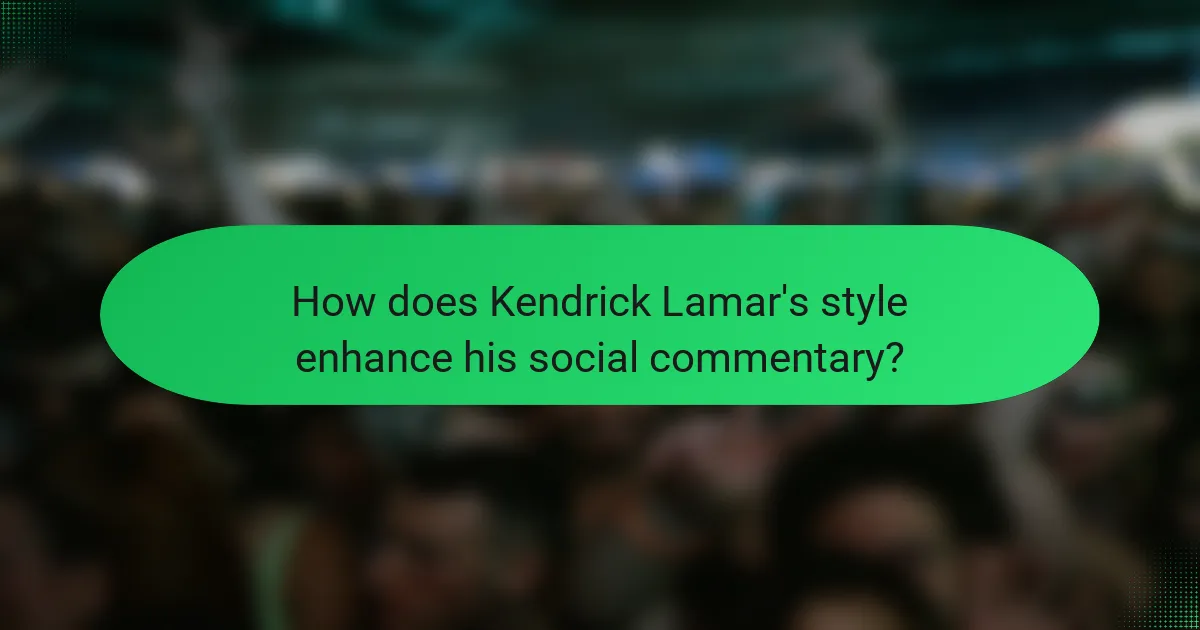
How does Kendrick Lamar’s style enhance his social commentary?
Kendrick Lamar’s style enhances his social commentary through intricate lyricism and diverse musical influences. His use of storytelling allows listeners to connect with personal and societal experiences. Lamar often employs vivid imagery, which paints a clear picture of the issues he addresses. His varied vocal delivery adds emotional weight to his messages. The incorporation of different genres, such as jazz and funk, enriches the narrative and engages a wider audience. Additionally, Lamar’s strategic use of metaphors deepens the impact of his commentary. His work often reflects real-life events, grounding his messages in authenticity. For instance, his album “To Pimp a Butterfly” tackles themes of racial inequality and identity, resonating with contemporary social issues.
What role does storytelling play in Kendrick Lamar’s lyrics?
Storytelling is central to Kendrick Lamar’s lyrics. It allows him to convey complex social issues and personal experiences. Through narrative, he explores themes such as race, poverty, and identity. Lamar often uses characters and scenarios to illustrate broader societal problems. His storytelling creates emotional connections with listeners. For example, in “The Art of Peer Pressure,” he narrates a day in his life that highlights the influence of his environment. This approach makes his messages more relatable and impactful. Additionally, storytelling in his music fosters a deeper understanding of the struggles faced by marginalized communities.
How does he use personal narratives to convey broader societal messages?
Kendrick Lamar uses personal narratives to convey broader societal messages by intertwining his life experiences with larger social issues. He shares stories of his upbringing in Compton, which reflect systemic racism and economic struggles. For example, in “The Art of Peer Pressure,” he narrates a day in his life that highlights peer influence and the impact of environment on choices. This personal storytelling allows listeners to connect emotionally with the realities faced by marginalized communities. Additionally, Lamar addresses themes like violence and identity, as seen in “m.A.A.d city,” where he recounts his experiences with gang culture. These narratives serve as powerful metaphors for broader societal problems, making complex issues accessible and relatable.
What literary devices does he employ to enrich his commentary?
Kendrick Lamar employs various literary devices to enrich his commentary. He frequently uses metaphor to draw parallels between personal experiences and broader societal issues. For example, in “The Blacker the Berry,” he uses the metaphor of color to discuss racial identity and systemic oppression. Lamar also utilizes imagery to create vivid pictures that evoke emotional responses. His use of alliteration enhances the musicality of his lyrics, making the commentary more engaging. Additionally, he employs symbolism, such as in “Alright,” where the phrase symbolizes hope amid adversity. These devices work together to deepen the impact of his social commentary.
How does Kendrick Lamar’s music reflect current social movements?
Kendrick Lamar’s music reflects current social movements by addressing systemic racism and social inequality. His lyrics often highlight the struggles faced by marginalized communities. For instance, the song “Alright” became an anthem for the Black Lives Matter movement. It encapsulates hope amidst adversity, resonating with activists. Additionally, his album “To Pimp a Butterfly” delves into themes of identity and oppression. The track “The Blacker the Berry” confronts issues of racial identity and violence. Lamar uses personal narratives to illustrate broader societal issues. His storytelling approach fosters empathy and awareness among listeners. Through his work, he amplifies the voices of the oppressed, making his music a powerful tool for social change.
What connections can be drawn between his lyrics and movements like Black Lives Matter?
Kendrick Lamar’s lyrics often reflect themes of racial injustice and systemic oppression. His song “Alright” has become an anthem for the Black Lives Matter movement. The repeated phrase “We gon’ be alright” resonates with activists seeking hope amidst struggle. Lamar addresses police brutality and the experiences of Black individuals in America. For instance, in “The Blacker the Berry,” he confronts issues of identity and systemic racism. His storytelling captures the pain and resilience of marginalized communities. The emotional depth in his music aligns closely with the goals of movements like Black Lives Matter. Overall, Lamar’s work serves as both a critique and a call to action against racial inequality.
How does he inspire action and awareness through his art?
Kendrick Lamar inspires action and awareness through his art by addressing social issues in his lyrics. His songs tackle themes such as racial inequality, police brutality, and mental health. By sharing personal stories and experiences, he connects with listeners on an emotional level. Lamar often uses vivid imagery and powerful narratives to highlight injustices. For example, his song “Alright” became an anthem for the Black Lives Matter movement. He encourages listeners to reflect on their own experiences and take action. His art serves as a platform for marginalized voices. By blending storytelling with social commentary, Lamar fosters awareness and inspires change.
What can listeners learn from Kendrick Lamar’s social commentary?
Listeners can learn about systemic racism and social injustice from Kendrick Lamar’s social commentary. His lyrics often address the struggles faced by marginalized communities. For example, in “Alright,” he conveys hope amidst adversity. Lamar also discusses mental health issues, particularly in “u,” where he explores self-doubt and trauma. His storytelling highlights personal experiences that reflect broader societal issues. By using vivid imagery, he makes complex themes accessible. Lamar’s work encourages listeners to engage with difficult conversations about race and identity. Overall, his commentary serves as a catalyst for awareness and social change.
How can fans apply his insights to their own understanding of social issues?
Fans can apply Kendrick Lamar’s insights to their understanding of social issues by analyzing his lyrics. His songs often address systemic racism, poverty, and mental health. By reflecting on these themes, fans can gain deeper awareness of societal challenges. Lamar’s storytelling provides personal perspectives on collective experiences. This encourages listeners to empathize with marginalized communities. Engaging with his work can inspire critical discussions about social justice. Fans can also relate his experiences to their own lives. This connection fosters a more informed and compassionate worldview.
What are some practical takeaways from Kendrick Lamar’s lyrical messages?
Kendrick Lamar’s lyrical messages emphasize self-awareness, resilience, and social justice. He encourages listeners to reflect on personal identity and societal issues. His songs often address themes of racial inequality and systemic oppression. Lamar’s work advocates for empowerment through education and self-improvement. He highlights the importance of mental health and emotional expression. His storytelling approach provides relatable narratives that inspire change. Through his music, he fosters a sense of community and solidarity. These takeaways resonate with audiences seeking to understand and navigate complex social dynamics.
The main entity of this article is Kendrick Lamar, a prominent artist known for his impactful social commentary in music. The article explores how Lamar addresses systemic issues such as racism, poverty, and violence through his lyrics, highlighting personal narratives that connect individual experiences to broader societal problems. Key themes include racial inequality, mental health, and identity, with specific examples from his songs like “Alright” and “The Blacker the Berry.” Additionally, the article discusses how Lamar’s storytelling enhances his social critique and resonates with diverse audiences, making his work a powerful platform for dialogue and awareness regarding social justice issues.
